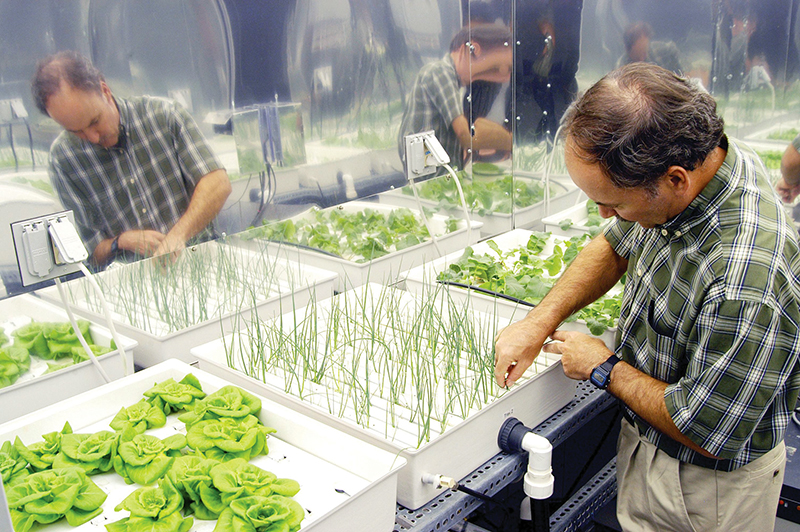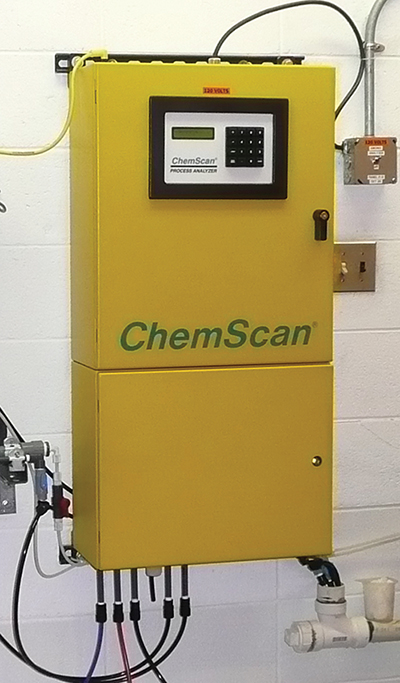
Systems Analyze Water Quality in Real Time
Originating Technology/NASA Contribution
If you are planning a day at your local park or even a weekend camping trip, you would simply pack all the food, drink, and supplies you need. Similarly, astronauts on short-term space missions can get away with packing the provisions they need to survive in space. But long-term space travel—a round-trip journey to Mars, for example—is no picnic. Depending on the mission, astronauts would need enough food to last for several months or years; a means to clean the air and water; and some efficient way of dealing with waste. Given cost and space limitations, packing supplies on this scale may not be feasible, meaning astronauts need a system that provides a steady source of sustenance while at the same time purifying and recycling waste. The best solution, then, for future deep space explorers: Develop a green thumb.
Earth is a closed, self-sustaining system. We depend on the planet’s regenerative ecosystems to supply all of our biological needs. The central facilitators of these ecosystems are plants. The same qualities that make plant life essential on Earth make it an ideal engine for long-term life support in space. Plants actively purify and recycle air supplies, absorbing carbon dioxide and noxious fumes while releasing oxygen. They also provide a regenerating food supply, transpire water vapor into the air that can be condensed and collected for drinking, and filter contaminants in water through their root systems. For these reasons, NASA has long studied methods for growing and maintaining plants in space as part of a controlled (or closed) ecological life support system (CELSS) for long-term space missions.
Growing plants in space presents unique challenges. For one, soil may not be optimal due to its payload weight, the problem of particles floating about in zero gravity, and the potential for harboring health-threatening, soil-borne pathogens. To address this issue, many NASA projects—including the BioHome, the CELSS Breadboard Project, the Advanced Astroculture Spaceflight Experiments, and the Lunar-Mars Life Support Test Project—have focused on developing and improving hydroponic methods of plant cultivation for use in space. Hydroponics is the practice of growing plants in nutrient solutions, without true soil. This method not only proves more practical for space-based agriculture, but also typically produces larger, healthier plants.
Partnership
As part of NASA’s Advanced Life Support Program, Kennedy Space Center sought methods for monitoring the nutrient components in hydroponic solutions. The solutions typically contain a variety of mineral elements and ions that are taken up at different rates by different plants and need to be replenished when their concentrations drop below ideal levels. Working with Kennedy scientist Dr. Ken Schlager under Phase I and II Small Business Innovation Research (SBIR) contracts, Biotronics Technologies Inc., of Waukesha, Wisconsin, developed a process analyzer that provides real-time detection of nutrients, organics, and metals in water.
Biotronics recognized a host of uses for the technology beyond hydroponic solution monitoring, including water and wastewater analysis and certain industrial applications. Commercial funding from W. R. Grace & Co. led Biotronics to adapt the SBIR-developed technology for analyzing solutions related to Grace’s cooling and boiler water treatment business. Biotronics then began exploring environmental applications, particularly water and wastewater monitoring at municipal treatment facilities. Realizing the commercial potential of the technology, a group of researchers at Biotronics purchased the rights to the technology from the company and created Applied Spectrometry Associates Inc. (now called ASA Analytics Inc.), also headquartered in Waukesha.
Product Outcome
The original process analyzer technology developed with NASA SBIR funding now takes the form of ASA’s ChemScan product line. More than 500 ChemScan analyzer systems currently monitor the treatment processes at water and wastewater facilities around the world and help maintain water quality in major American cities like Los Angeles, New York, Phoenix, Las Vegas, Orlando, and Tampa.
“Water and wastewater treatment plants are basically biochemical factories,” says Bernie Beemster, president of ASA. “Water is rarely found in pure form. It contains any number of contaminants and other chemical and biological constituents that need to be found and removed.” The processes that cleanse wastewater and make tap water potable require a number of steps, Beemster says, each of which have control requirements based on measured parameters. Using fully automated basic spectrometry and an array-based absorbance spectrometer, the ChemScan analyzer measures absorbance levels across 256 wavelengths of ultraviolet and visible light in a sample. The resulting data are processed using chemometrics—mathematical and statistical algorithms used in this case to determine an absorption pattern that indicates the presence of a particular chemical.
Earlier technology would require water samples to be physically extracted from various points along the treatment process and taken to a lab for analysis—a time consuming and labor intensive procedure that left significant gaps between measurements. ChemScan’s capabilities allow it to automatically draw and analyze samples for multiple parameters within a water treatment process, including ammonia and other nutrient levels, water hardness, chloramination (a disinfectant process), or amounts of natural organic matter. The analyzer ties directly into the treatment facility’s control system, which uses the information ChemScan provides to automatically adjust its processes, minimizing the need for operator intervention. ChemScan analyzers require little maintenance or calibration, making them a cost-efficient technology.
“The sum total of what ChemScan provides is a small fraction of the price that would be required to do the same task with other technologies,” says Beemster.
While populations across the globe can credit the ChemScan analyzers with helping ensure the quality of their water supplies, Beemster credits the NASA SBIR-developed technology as the core reason for his company’s success. “Over the 15 years of our history, we’ve had a compound annual growth rate of 40 percent as a direct result of this unique technology,” Beemster says. “That’s pretty remarkable.”
ChemScan® is a registered trademark of ASA Analytics Inc.

The ChemScan analyzer ties directly into a treatment facility’s control system, minimizing the need for operator intervention.

Hydroponic techniques—like those used to grow these onions, lettuce, and radishes in this plant growth chamber in Kennedy Space Center’s Space Life Sciences Laboratory—may one day contribute to the development of a bioregenerative life support system.













